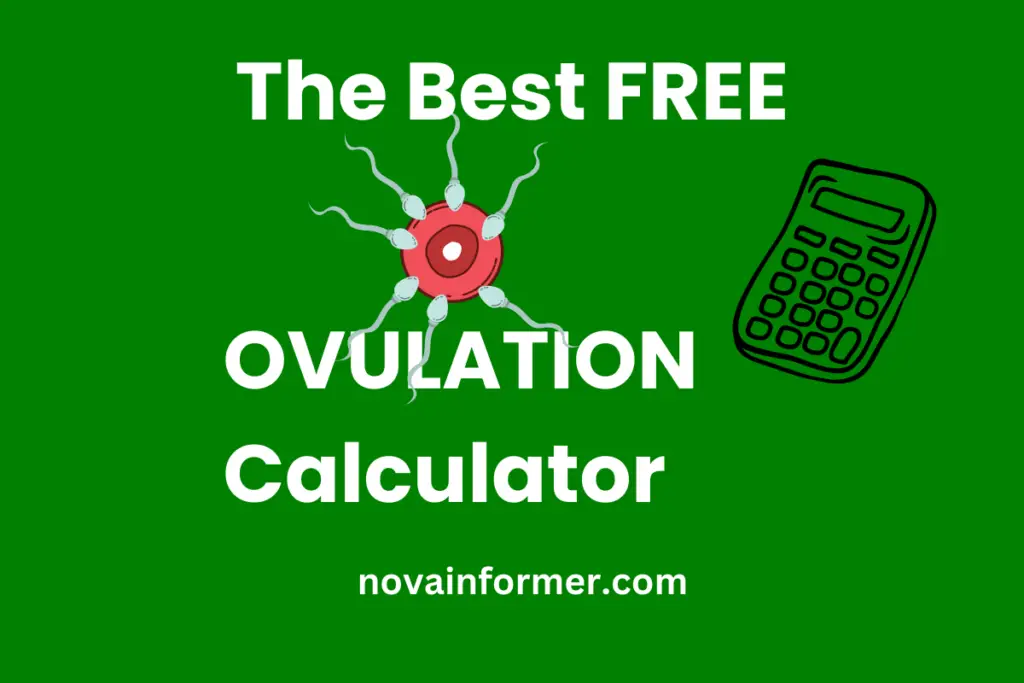Our free ovulation calculator will help you determine your ovulation day.
This calculator is based on an average 28 day cycle. Cycle length varies.
This is a one day event, but the days surrounding ovulation can leave you feeling even more energized. Around the end of week two to the beginning of week three, which for most women is ovulation time, you may find that you can withstand higher levels of exertion than during other times of the month.
Key Takeaways:
- Ovulation is a crucial part of the menstrual cycle, key to fertility.
- Signs like changes in cervical mucus and ovulation pain can indicate ovulation.
- Various methods, including ovulation predictor kits and apps, help track ovulation accurately.
Introduction to Ovulation
Ovulation, a term often associated with fertility, plays a pivotal role in the menstrual cycle. It marks the release of an egg from the ovary, creating the optimal conditions for conception. Let’s delve into the intricacies of ovulation and how it shapes the female reproductive journey.
Menstrual Cycle Basics
The menstrual cycle is a beautifully orchestrated dance of hormones and physiological changes. Divided into phases, it sets the stage for ovulation. Two key players, estrogen and progesterone, influence these phases, creating a harmonious balance necessary for fertility.
Signs and Symptoms of Ovulation
Changes in Cervical Mucus
One of the tangible signs of approaching ovulation is a change in cervical mucus. This natural fluid becomes clearer, stretchier, and more slippery, resembling egg whites. This environment aids sperm in reaching the awaiting egg.
Basal Body Temperature (BBT) Tracking
Monitoring your basal body temperature provides insights into your menstrual cycle. A slight temperature rise after ovulation indicates the release of an egg, helping predict fertile days.
Ovulation Pain (Mittelschmerz)
Some women experience ovulation pain, a mild twinge or discomfort on one side of the lower abdomen. While not universal, it’s a notable sign for those attuned to their bodies.
Ovulation Prediction Methods
Ovulation Predictor Kits (OPKs)
OPKs are handy tools that detect the surge in luteinizing hormone (LH) – a signal that ovulation is imminent. These kits provide a visual cue, making it easier to pinpoint fertile days.
Fertility Awareness Methods
Charting menstrual cycles, monitoring cervical mucus, and tracking basal body temperature fall under fertility awareness methods. While requiring diligence, they offer valuable insights into ovulation patterns.
Smartphone Apps for Ovulation Tracking
In the digital age, numerous apps simplify ovulation tracking. They incorporate data inputs and algorithms to predict fertile windows, empowering women with user-friendly fertility tools.
Table 1: Ovulation Signs and Methods
| Signs/Methods | Description |
|---|---|
| Changes in Cervical Mucus | Clearer, stretchier, and slippery mucus resembling egg whites during fertile days. |
| Basal Body Temperature (BBT) | A slight temperature rise post-ovulation, indicating fertile days. |
| Ovulation Pain (Mittelschmerz) | Mild twinge or discomfort on one side of the lower abdomen during ovulation. |
| Ovulation Predictor Kits (OPKs) | Detect LH surge, signaling imminent ovulation. |
| Fertility Awareness Methods | Charting menstrual cycles, monitoring mucus, and tracking BBT for ovulation prediction. |
| Smartphone Apps | Digital tools utilizing algorithms to predict fertile windows based on user-inputted data. |
In the upcoming sections, we’ll explore factors influencing ovulation and how to enhance fertility naturally. Buckle up, we’re just getting started on this fascinating journey.
Now that we’ve laid the foundation by understanding ovulation and its signs, let’s explore the various factors that can influence this pivotal phase of the menstrual cycle.
How to Use the Ovulation Calculator
Welcome to our Ovulation Calculator – a helpful tool designed to estimate your ovulation date. Here’s a quick guide on how to use it:
- Enter Your Last Period Date:
- Locate the “What was the date of the first day of your last period?” question.
- Tap the input field next to it to open a calendar.
- Choose the date of the first day of your last period.
- Click the “Calculate” Button:
- Find the blue “Calculate” button below the date input.
- Click it to initiate the calculation process.
- View Your Ovulation Date:
- After clicking, the tool will swiftly process the information.
- Your estimated ovulation date will appear in the box below, highlighted in bold.
And that’s it! You now have an approximate date for your ovulation.
Remember, this tool provides a general estimation, and individual cycles may vary. For more personalized advice, consider consulting with a healthcare professional. Happy tracking!
Impact of Age on Ovulation
As women age, the dynamics of ovulation undergo changes, influencing fertility patterns. Let’s unravel the impact of age on this intricate process.
Ovulation Patterns in Different Life Stages
Ovulation isn’t a static phenomenon; it evolves across various life stages. During puberty, ovulation initiates, signaling reproductive readiness. As women age, the regularity and predictability of ovulation can fluctuate, impacting fertility.
Fertility Concerns with Age
As the biological clock ticks, fertility can decline. The quantity and quality of eggs diminish, making conception more challenging. Understanding age-related fertility changes empowers women to make informed family planning decisions.
Hormonal Influences on Ovulation
The delicate balance of hormones orchestrates ovulation. However, hormonal imbalances or specific disorders can disrupt this harmonious interplay.
Disorders Affecting Ovulation
- Polycystic Ovary Syndrome (PCOS):
- A common hormonal disorder affecting ovulation.
- Imbalances in insulin and androgens contribute to irregular ovulation patterns.
- Hypothalamic Amenorrhea:
- Disruption in the hypothalamus affecting hormonal signals.
- Stress, excessive exercise, or low body weight can lead to amenorrhea (lack of menstruation) and ovulatory issues.
Hormonal Contraceptives and Their Impact
While birth control pills are effective contraceptives, they temporarily suppress ovulation. Understanding the implications of hormonal contraceptives is crucial for those planning to conceive in the future.
Table 2: Hormonal Influences on Ovulation
| Hormonal Factors | Description |
|---|---|
| Polycystic Ovary Syndrome (PCOS) | Common hormonal disorder affecting ovulation. Imbalances in insulin and androgens contribute to irregular ovulation patterns. |
| Hypothalamic Amenorrhea | Disruption in the hypothalamus affecting hormonal signals. Stress, excessive exercise, or low body weight can lead to amenorrhea and ovulatory issues. |
| Hormonal Contraceptives | Birth control pills suppress ovulation temporarily. Understanding their impact is crucial for those planning future pregnancies. |
Nutrition and Lifestyle Factors
Beyond hormonal influences, lifestyle choices and nutrition play a pivotal role in supporting or hindering ovulation.
Diet’s Influence on Hormonal Balance
- Balanced Nutrition:
- Adequate intake of essential nutrients supports hormonal balance.
- Nutrients like omega-3 fatty acids, antioxidants, and vitamin D are beneficial for reproductive health.
The Role of Stress in Ovulation
- Cortisol and Ovulation:
- Chronic stress can elevate cortisol levels, impacting reproductive hormones.
- Stress management techniques, such as mindfulness and relaxation, can positively influence ovulation.
Exercise and Its Impact on Fertility
- Moderation Matters:
- Moderate exercise supports overall health, including reproductive health.
- Excessive exercise, on the other hand, may disrupt hormonal balance and ovulation.
Table 3: Lifestyle Factors Impacting Ovulation
| Lifestyle Factors | Description |
|---|---|
| Balanced Nutrition | Adequate intake of essential nutrients, including omega-3 fatty acids, antioxidants, and vitamin D, supports hormonal balance and ovulation. |
| Cortisol and Ovulation | Chronic stress elevates cortisol levels, impacting reproductive hormones. Stress management techniques positively influence ovulation. |
| Exercise and Fertility | Moderate exercise supports overall health, while excessive exercise may disrupt hormonal balance and ovulation. |
In the next section, we’ll explore practical ways to enhance ovulation naturally, covering dietary recommendations, lifestyle changes, and herbal supplements. Stick around for more insights on this fascinating journey into fertility.
In this section, we’ll uncover practical strategies to naturally enhance ovulation. From dietary adjustments to lifestyle tweaks, let’s embark on this holistic journey.
Boosting Fertility Naturally
Understanding that fertility is not solely determined by biological factors empowers individuals to actively participate in their reproductive well-being.
Dietary Recommendations for Fertility
- Antioxidant-Rich Foods:
- Incorporate fruits, vegetables, and nuts rich in antioxidants.
- Antioxidants protect eggs and sperm from free radical damage.
- Omega-3 Fatty Acids:
- Include fatty fish, chia seeds, and flaxseeds in your diet.
- Omega-3 fatty acids support hormonal balance and reproductive health.
- Iron-Rich Foods:
- Opt for lean meats, legumes, and leafy greens.
- Iron is vital for preventing anemia, which can impact fertility.
Lifestyle Changes to Support Ovulation
- Manage Stress:
- Practice stress-reducing activities like yoga and meditation.
- Stress management positively influences hormonal balance and fertility.
- Adequate Sleep:
- Ensure 7-9 hours of quality sleep per night.
- Sleep plays a crucial role in hormone regulation and overall well-being.
- Moderate Exercise:
- Engage in moderate, regular exercise.
- Balance is key; excessive exercise may disrupt ovulation.
Herbal Supplements and Their Effects
- Chasteberry (Vitex):
- Traditional herb believed to support hormonal balance.
- Consult with a healthcare professional before incorporating herbal supplements.
- Maca Root:
- Peruvian herb linked to improved fertility.
- Limited research suggests potential benefits.
Table 4: Strategies for Enhancing Ovulation Naturally
| Natural Strategies | Description |
|---|---|
| Antioxidant-Rich Foods | Fruits, vegetables, and nuts protect eggs and sperm from free radical damage. |
| Omega-3 Fatty Acids | Fatty fish, chia seeds, and flaxseeds support hormonal balance and reproductive health. |
| Iron-Rich Foods | Lean meats, legumes, and leafy greens provide essential iron for preventing anemia, which can impact fertility. |
| Manage Stress | Stress-reducing activities like yoga positively influence hormonal balance and fertility. |
| Adequate Sleep | 7-9 hours of quality sleep per night plays a crucial role in hormone regulation and overall well-being. |
| Moderate Exercise | Regular, moderate exercise supports overall health, with balance being key to preventing disruption of ovulation. |
| Chasteberry (Vitex) | Traditional herb believed to support hormonal balance. Consult with a healthcare professional before use. |
| Maca Root | Peruvian herb linked to improved fertility; limited research suggests potential benefits. |
In the final section, we’ll explore medical interventions for ovulation issues and address common questions in the FAQs section.
Stay tuned for a comprehensive wrap-up of our journey through the intricate landscape of ovulation.
As we reach the culmination of our exploration into ovulation, let’s unravel the realms of medical interventions and address commonly asked questions.
Whether you’re seeking solutions for ovulation challenges or simply expanding your knowledge, this section has you covered.
Medical Interventions
When natural methods fall short, medical interventions provide viable options for addressing ovulation issues.
Fertility Treatments and Medications
- Clomiphene Citrate:
- Oral medication stimulating ovulation.
- Commonly prescribed for women with irregular ovulation.
- Gonadotropins:
- Injectable hormones stimulating egg development.
- Administered under medical supervision during fertility treatments.
In Vitro Fertilization (IVF)
- The IVF Process Explained:
- Ovulation induction to retrieve multiple eggs.
- Fertilization in a laboratory setting before implantation in the uterus.
- When to Seek Medical Help:
- Persistent irregularities in menstrual cycles.
- Unsuccessful attempts at conception after a year of regular, unprotected intercourse.
Table 5: Medical Interventions for Ovulation Issues
| Medical Interventions | Description |
|---|---|
| Clomiphene Citrate | Oral medication stimulating ovulation; commonly prescribed for women with irregular ovulation. |
| Gonadotropins | Injectable hormones stimulating egg development; administered under medical supervision during fertility treatments. |
| In Vitro Fertilization (IVF) | Process involves ovulation induction, egg retrieval, fertilization, and implantation in the uterus. |
| When to Seek Medical Help | Persistent irregularities in menstrual cycles or unsuccessful attempts at conception after a year of regular, unprotected intercourse. |
FAQs Section
What is the best time for conception during ovulation?
The optimal time for conception is the fertile window, usually around the middle of the menstrual cycle.
Can stress prevent ovulation?
Chronic stress can impact hormonal balance and potentially disrupt ovulation.
Are irregular periods a sign of ovulation problems?
Irregular periods may indicate ovulation issues. Consult a healthcare professional for evaluation and guidance.
How long does ovulation last?
Ovulation typically lasts for 12-24 hours, and the fertile window extends a few days before and after this period.
Can you ovulate without a period?
Yes, ovulation can occur without a period, especially in conditions like polycystic ovary syndrome (PCOS).
What factors affect ovulation?
Various factors, including age, hormonal imbalances, and lifestyle choices, can influence ovulation.
What are the early signs of pregnancy post-ovulation?
Early signs include implantation bleeding, changes in cervical mucus, and mild cramping.
How does Clomiphene Citrate work?
Clomiphene Citrate stimulates the release of hormones essential for triggering ovulation.
In Conclusion
Understanding ovulation involves a multifaceted exploration of biological processes, lifestyle choices, and potential interventions.
Whether you’re on a quest for conception or simply expanding your knowledge, this journey through the intricacies of ovulation offers valuable insights. May your path to fertility be both informed and empowering.
License:
by Heba S (https://codepen.io/Heba-S-the-builder/pen/gOqOMWa)



